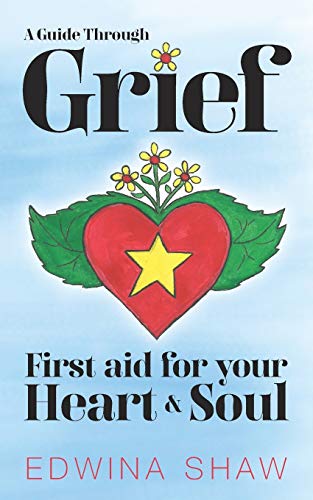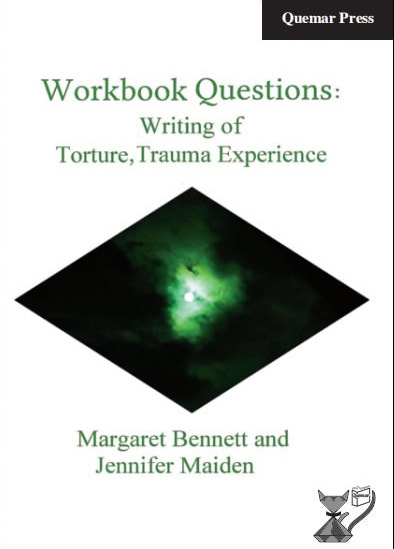I’m not the intended audience for either of these books, but they’re both written, or co-written, by writers whose work I love. One of the writers is my niece. Each of the books is related to its author’s other job: Edwina is a yoga teacher when she’s not writing, and Jennifer Maiden has been employed as Writer in Residence at STARTTS (NSW Service for the Treatment and Rehabilitation of Torture and Trauma Survivors).
Edwina Shaw, A Guide Through Grief: First aid for your heart and soul (Red Backed Wren 2020)
Edwina’s book has a further subtitle on the title page: ‘Practical tools, creative activities and yoga exercises to help you cope with the loss of someone you love’. It announces itself as a self-help book. OK, I’m deeply suspicious of self-help books so, as blood’s not thicker than prejudice, I approached A Guide through Grief with my defences up.
It turns out that, yes, there are plenty of practical tools etcetera. At the end of each chapter there are several suggested activities: journalling and other writing tasks, affirmations à la Louise Hay, rituals with a New Age feel, the promised yoga exercises, and some recipes. Some or all of these may hit just the right note for some readers, and I’ve got nothing against a good recipe for chicken soup, but if that’s all there was to the book my heart would have hardened against it. (Luckily, an introductory ‘How to use this book’ explicitly invites readers to turn up their noses at some exercises, depending on taste.)
But the book is also a memoir. Edwina’s reflections on grief and loss, the need to weep and to stay connected, the importance of facing the reality rather than taking refuge in work or destructive activity of one kind or another, the passage of time – all these are entwined with accounts of personal experience. The book is rooted in her own bereavements: her father died of cancer when she was 14, her younger brother killed himself not long after, her grandmother died a peaceful death in old age, and then, devastatingly, decades later, a baby son died soon after birth. The self-help advice and suggestions have been tested in the laboratory of the writer’s own life, and she shows at least some of her workings.
I had tears in my eyes in many places. Partly this is because three of its four main deaths affected me deeply at the time. (I was ridiculously pleased to read in the paragraph about the impersonal remoteness of her brother’s funeral on page 110: ‘Only my uncle’s speech reflected the true essence of Matty’s personality.’ At least I’d been part of bucking the trend.) It’s also because Edwina can write. I happen to have read this book as I’m making my way, three pages a day, through Proust’s account of bereavement in the sixth volume of À la recherche du temps perdu. I’m not suggesting that Edwina Shaw and Marcel Proust are in any way similar writers, but Proust’s description of humans as ‘amphibious creatures who are immersed simultaneously in the past and in present-time reality’, which I read this morning, resonates through Edwina’s accounts of the role of memory in grieving.
The book does an elegant two-step: it evokes one person’s experience of loss and her grieving work, and gives practical suggestions on how the reader can do their own work. I skipped the yoga and I skim-read the affirmations; you might ignore the writing exercises – which I might actually try. I doubt if I’ll ever practise a ‘visualisation’ in which I sit naked on the lap of a mother goddess, but I’ll remember Edwina’s wise aunt who said that ‘for every death there is one hundred hours’ worth of crying’. I love her argument for wrenching funerals from the control of religious institutions and for-profit enterprises. Edwina says in her introduction that this is the book she wishes someone had given her when she was 14. I hope I’d have the moral fibre to give it to someone in that situation: it could save lives.
Margaret Bennett & Jennifer Maiden, Workbook Questions: Writing of Torture, Trauma Experience (Quemar Press 2019)
Workbook Questions is what it says on the lid: 47 pages of carefully-devised questions intended as prompts in writing exercises for ‘Torture and Related Trauma Survivors and for Survivors of Camps and Incarceration’. So the main intended audience is limited – though an opening section of ‘General Questions’ is designed to make the book useful to anyone addressing trauma of any sort, not just torture and incarceration, which is a much broader readership/user base. It turns out that the list of questions is preceded by a 30-page ‘Conversation’ between the authors: Margaret Bennett, former Executive Director of STARTTS with a background in group therapy and counselling, and Jennifer Maiden, poet.
A more conventional presentation might have spelled out a carefully referenced rationale for the questions, probably with each question numbered for easy cross-reference: ‘The reasons for starting out with neutral questions about parents are as follows,’ etcetera.
Although such explanations are covered in the ‘conversation’, it is much more interesting and readable than that. Two women who have worked with each other and know each other well discuss the circumstances that led to this set of questions, the insights they bring from their different experiences and expertise, what they found worked in the groups, the value of writing as opposed to speaking as a way of integrating traumatic experiences, and autobiographical anecdotes.
Maiden and Bennett take turns in speaking/writing, and each turn is printed as a single paragraph. As these paragraphs can run for several pages and cover a range of topics, the reader has to do work that would be done by an editor in a more conventionally presented work, but the work pays off. I imagine that this conversation will be very useful, not only to people working with survivors of torture, trauma and incarceration, but also to to scholars interested in Jennifer Maiden’s poetry, in which these themes appear frequently.
A Guide through Grief and Workbook Questions are the 20th and 21st books I’ve read for the 2020 Australian Women Writers Challenge.










